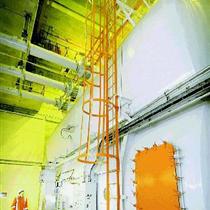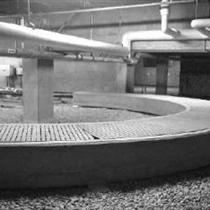

$5-billion fixup a B.C. grid priority
In a multi-part series, Vancouver Sun reporter Scott Simpson and photographer Ian Lindsay are documenting the new infrastructure and coming challenges involved in B.C.'s massive $5.1-billion effort to create a modern, efficient and reliable electricity transmission grid
Scott Simpson
Vancouver Sun
Friday, June 20, 2008

Station C field operations manager Scot Jackson
stands alongside a massive 230-kilovolt transformer,
sealed to contain carbon dioxide emissions, at the
underground substation that keeps the lights burning
in downtown Vancouver.
CREDIT: Ian Lindsay, Vancouver Sun

One of the 230-kilo volt lines supplying the underground
substation comes through the wall before curving
gracefully toward the switching chamber.
Scot Jackson of BC Hydro inspects.
CREDIT: Ian Lindsay, Vancouver Sun
Scot Jackson was on the job a week when the trouble started. Deep in the guts of a $3-million high-voltage transformer buried in an underground electrical substation in downtown Vancouver, swaddled in 50,000 litres of cooling oil, a $50 component had begun to cause an electrical arc.
Acetylene gas was building up in the transformer's oil-filled shell. Unattended, it could elevate the risk of an explosion or fire that would damage the transformer -- a custom-built unit that plays a critical role in keeping the lights on in the heart of Vancouver's business district.
It was, according to BC Transmission Corp. capital programs adviser Gerhard Kehl, "the mother of all problems."
BC Hydro and BC Transmission Corp. maintain a constant vigil on equipment at 291 substations around the province -- but none more intent than Station C, where a minor repair might take weeks but the replacement of a 120-tonne transformer would take 18 months due to the unique location.
The transformers rest on concrete pads six stories below street level, in a compact venue less than half the size of a comparable ground-level substation.
Nobody expected trouble here.
Most of the transmission equipment on the B.C. power grid is 40 to 50 years old, and many of those aging assets -- transmission towers, substations and electrical circuits -- are in "poor or very poor condition," according to a BCTC study.
The most recent estimate to upgrade the system is $5.1 billion over the next decade, but the Crown corporation is warning that the final bill could be billions more.
The transformers at Station C are merely middle-aged and were not considered immediate candidates for replacement.
Jackson took over as field operations manager in July 2007, with his predecessor telling him confidently that he'd done a Station C walk-through the month before and found it to be as robust and stable as ever.
"He said, 'We haven't had a lick of problem with these transformers since they were installed,'" Jackson recalled.
The downtown demand for air conditioning had both transformers -- original equipment dating to the 1984 opening of Station C -- humming.
Either one of the transformers was individually capable of meeting all demand without overheating. But the system would have no backup unit if one failed.
One did. And Jackson had been on the job for less than a week.
The gas monitor inside one of the transformers triggered an emergency shutoff. It took two tanker trucks and a permit from Vancouver city hall just to drain the oil off so that workers could begin to look for the source of the failure.
BC Hydro and BCTC urged downtown building operators to cut back on electricity consumption by tweaking their thermostats up a couple of degrees.
"We were coming into the hottest weather in July," Jackson said.
The sole remaining transformer "was almost at capacity and so we didn't know, with air conditioners set at 20 or 21 degrees, how much more load that would put on the system."
As it turned out, the functioning transformer never got close to overheating as Jackson and his crews worked, for 21 days straight, to find the problem, fix it, and get the failed transformer back in operation.
It was, nevertheless, an anxious time.
"We never did have to move any transformers out. If we did, that would have been a major, major effort to get it up to street level, and out onto the street," said Gerhard Kehl.
Electrical engineers don't like risk.
"When one [transformer] fails, everybody gets antsy because, geez, if the other one fails then the customers served from this station would be without power."
As it turned out, the system functioned smoothly on a single transformer.
If it had needed replacement, however, BCTC would still be scrambling, even now, to install a new one.
With the Olympic Games coming in less than two years, and both residential and commercial construction booming downtown, BCTC is taking no chances of a similar occurrence in the future.
"We have an empty transformer space downstairs, and we will be filling that up in the next year," Jackson said.
"We want that third one so we will always have two transformers to take the load, and be able to take that third one out for servicing."
As a measure of the difficulty associated with squeezing a transformer into an underground bunker, consider this: A new transformer is worth $3 million, but the full cost of putting one into Station C is $13.6 million.
Adding another transformer makes the downtown grid more reliable, but there is also a vast amount of BCTC equipment across British Columbia that's 20 years older than Station C, and considered more likely to fail.
Coming into 2007, BCTC's prevailing estimate was approximately $3.2 billion over 10 years to carry out all the necessary work.
Greater scrutiny revealed far greater problems -- and earlier this year, BCTC announced it would need about $5.1 billion.
That's more than a $1.8-billion price increase just within the past year.
And so, while that increase is about five times the cost overrun of the new Vancouver Convention Centre (which, coincidentally, draws its power from Station C), there is no apparent scandal about runaway costs at BCTC.
The biggest criticism appears to be the Crown corporation's failure, since it was broken off from BC Hydro in 2003, to dare to put a big enough pricetag on the work ahead.
A recent independent appraisal of BCTC's performance in managing its assets found that the corporation, while a "solid asset manager," was not spending enough money to maintain the province's grid.
The system includes a transmission line circuit of 18,336 kilometres, 291 switching, distribution and capacitor stations, and interconnections to Alberta and the U.S. Pacific Northwest.
"The majority of the B.C. transmission system was built between 1960 and 1970, and is now between 40 and 50 years old," according to a BCTC news backgrounder on the $5.1-billion, 10-year project to improve the grid.
BCTC estimates $1.6 billion for "state of the art" replacement equipment that will bring the grid fully into the digital era.
System growth and expansion costs are projected at $3.4 billion, including $1 billion to connect new, clean and renewable energy sources to the grid as B.C. moves toward a stated government objective of being energy self-sufficient by 2016.
BCTC cautions that final cost of some projects could run far higher than estimates.
For example, just two years ago BCTC was predicting it would cost $300 million to construct a new transmission line between the southern Interior and the Lower Mainland.
Today, the project is estimated at $600 million, and BCTC is so concerned about rising costs that it is unwilling to confirm the final price -- in fact, it's asking the BC Utilities Commission to approve it without any firm price guarantee.
BCTC also said the cost of linking independent power producers to the grid jumped $600 million, and needs an extra $700 million to replace assets and keep pace with demand for energy in a growing province.
All of this adds up to a challenge for BCTC, which must transform itself from a low-profile power line utility into a fast-moving, dynamic construction entity with one of the largest public infrastructure budgets in B.C. history.
"When you take a look at a total of $5 billion, there will be hundreds and hundreds of projects," Jane Peverett, BCTC president and CEO, said in an interview.
Peverett is a former senior executive with a western natural gas utility who moved into the top job at BCTC three years ago.
"We're on what I call Phase Three of BCTC.
"Phase One was startup -- getting ourselves established as a separate company, getting our work processes in place, getting the skills to augment the very good talent we got out of BC Hydro.
"Phase Two was being fully operational -- actually conducting all the business we needed to conduct, doing it as a separate stand-alone company, doing it better and better every day.
"Phase Three is where we are right now. In addition to being a fully operational company, we are a huge growth and construction company.
"When we were setting up BCTC, we did not anticipate that."
Nor is BCTC confident that its current working price tag is enough to fix the system.
"There are projects we know of today that are either in the works or are well-planned. But then there are a number of projects that are future projects and they really need further study," BCTC chief financial officer Janet Woodruff said in an interview.
Julius Pataky, BCTC vice-president for system planning and asset management, said that trend is pushing up costs in a "very real" way.
"We are talking about a single transformer costing $2 million [in 2006] that is now costing us $3 million," Pataky said in an interview.
"The suppliers of our equipment are running flat out. The lead times have gone from eight months to 24 months, and in some cases to 48 months. We are basically reserving factory space to get some of this equipment manufactured."
B.C. energy sector commentator David Austin said the biggest reason for the $1.8-billion jump isn't skyrocketing equipment prices, or demand growth. It's the fact that British Columbia's transmission assets were taken for granted through the 1990s, and not enough was spent to maintain them.
The former NDP government, he said, diverted potential grid maintenance funds to support other political priorities, and the long-term cost of that decision has finally begun to manifest itself.
"When you look at BC Hydro's accounts during the 1990s, they weren't even investing enough money to cover off the depreciation of their equipment, let alone the requirement to expand the electrical transmission system," Austin said in an interview.
"The electric utility business is like investing in your RRSP. You have to keep up with investment on an annual basis. If you defer it, you get caught by the inevitable ups and downs of the market -- including equipment, availability, inflation, currency exchange rates, and interest rates.
"Because the utility business is such a long-term business, investment should be made on an incremental basis and not on a stop-start basis.
"It's a long-term, boring business, where the winner is inevitably the tortoise and not the hare."
© The Vancouver Sun 2008
Posted by Arthur Caldicott on 21 Jun 2008